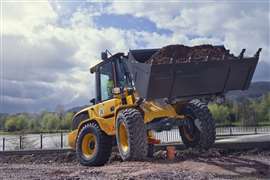Jan Denks is the sales director at Bronto Skylift. He gives Euan Youdale an illuminating insight into the big truck sector and where its opportunities lie.
Nestled in the vast coniferous forest of southern Finland, Bronto Skylift’s Tampere and Pori facilities produce some 200 truck mounts a year between them.
Jan Denks, as the company’s sales director for industrial equipment, is tasked with bringing this already well-established industrial product to the attention of a wider audience, and as a longstanding member of the Bronto team he is well placed to spot such opportunities, wherever they may lie. The company also has a large firefighting truck mounted platform division, based at the same premises.
In recent times, and despite the economic difficulties of the last few years, factory space at the Tampere headquarters and Pori have been extended by thousands of square metres.
APEX launch
It is at these production plants that Bronto has been concentrating on its latest XR range. The company launches a 47 m model, the S 47 XR at APEX, in June. It will follow on from the first two models in the XR range; the S 56 XR and S 65 XR launched at bauma last year, and are an evolution of Bronto’s longstanding XDT range.
As well as a 47 m working height, the model will include a 28 m outreach and cage capacity of 700 kg. Transport height is 3.6 m, while transport length is 9.9 m. The boom has a 540 degree rotation, while the cage is capable of 2 x 90 degree rotation.
The XR range shares a number of features, including 25% more up-and-over than previous models, 20% additional outreach and substantially increased extra working envelope.
“The shape of the boom is different and stronger, the material has improved and the welding process now uses a higher technology. All this results in more outreach and working height relative to the weight”.
Mr Denks could not reveal the steel type used, but confirmed the company has recently invested in new welding technology, which has started to be used with the XR range. At the top end of its range Bronto has a 112m model in its HLA range, which holds the world record for working height. The company also has the highest telescopic machine, the 78 m working height S 78 XDT.
Mr Denks says the 78 m height category is an obvious contender for the new XR range, which is set to be extended. But a range topper above 112 m is not a consideration at present. “I am not saying no, but we have no immediate plans. The 112 m is an important machine, not only for firefighting, but the wind turbine business too, as wind turbines have grown continuously which translates into higher access. But we are not planning on a 130 machine or anything like that.”
Mr Denks continues, “For Bronto, the large trucks have always been very popular; the 90 m Bronto has been one of our bestselling machines for many years. But Bronto is known for big machines, we don’t have plans to manufacturer 3.5 or 7.5 tonne machines.”
Wind is particularly ripe for growth in the USA, particularly for big truck mounts,” Mr Denks explains. Traditionally the USA is not as strong in using truck mounted platforms as Europe, but I think, regardless of tradition, the need for access is the same.”
Industrial growth
At the moment Bronto’s fire division provides 60% of revenue, while the industrial sector provides 40%. How does Mr Denks see that ratio changing over the next few years? “It’s very hard to predict the future. I think there are good reasons to think the industrial side of the market will grow in the next few years because there is a lot of backlog; many rental companies’ machines have aged while investment has been delayed. So, without even adding to the existing rental fleets, I think there is potential for growth by replacement alone. If we then get on to fleet growth or some new markets, I think we should see an increase in sales for the industrial side.”
Mr Denks adds, “It’s not really important where the revenue or the profits come from, whether it’s industrial or firefighting, the main thing is that we are a healthy, developing company with enough resources and profits to keep developing good products.”
Throughout the global recession of the last few years, Bronto kept its full capacity capabilities and its staff, without any redundancies; in fact, there has been additional recruitment in recent months.
Speaking of Bronto’s philosophy during the recession years, Mr Denks says, “On the one hand we chose to trust in the future, and on the other hand we had the privilege of the two markets, firefighting and industrial, which gave us continuity and enabled us to invest during difficult times in product development and production facilities. I think it’s an advantage for our customers that we are not entirely dependent on the very cyclical industrial business.”
Talking of those customers, namely rental companies, Mr Denks adds, “We haven’t had any causalities among our customers so I am optimistic and positive. Many of them have been investing and are planning to invest more this year. All the investments we have made in production and quality over the difficult years, have started to pay off now, and the industrial business is on the rise.”
Bronto Skylift will be exhibiting at APEX, taking place in Amsterdam this June, joining a great number of the world’s access-equipment manufacturers. Mr Denks sees specialist exhibitions like APEX as a valuable way to market the business, but takes a different view when it comes to other shows.
“Overall, it is good to exhibit your products and it’s a cost efficient opportunity to meet your customers. We have the important giant shows like bauma where everyone feels obliged to attend, predominantly to meet customers they haven’t heard of before, then you have the smaller, more specific exhibitions, like APEX or Vertikal Days, where you have a relatively small amount of visitors very relevant to you. The shows that are stuck in the middle are the ones that are suffering the most - the ones that are not clearly specific with a reasonable cost, but haven’t achieved the size of say bauma.”
Mr Denks adds, “We will look very carefully at our exhibition costs; there are certain big shows we will no doubt continue to participate in, along with some smaller and regional cost-efficient shows, but there are others stuck in the middle we might want to replace with demo tours, or customer factory visits, or a combination of both.”
Will Bauma China be on the list? “I don’t think we will be exhibiting there,” says Mr Denks, “We might have people visiting. It’s important to know what is happening in the market but I’m not so convinced the investment of exhibiting would be justified.”
At the moment big truck mounts are not particularly high on the agenda in the China industrial market. The two main drivers, health and safety and cost of labour have a long way to go before they take hold. As Mr Denks confirms, it is usually mainstream products like scissors and booms that make the running in an emerging nation first, which then opens the doors for more specialist equipment later on. “I can’t see the market, at least for big trucks, becoming very big in the near future.”
Boom competition
Bronto is continually fact-finding to establish new markets, but its traditional markets, particularly in northern Europe are going to provide the majority of sales in the near future. Although, as mentioned, the biggest potential for growth lies in North America, where Bronto has its own sales and service subsidiary.
“We are too small a player to shape a country or an industry,” says Mr Denks, “If say JLG or Genie decided to set up a manufacturing plant in Brazil and start producing thousands of units a year, that is a dimension in which we do not operate. I think we have to be humble and recognise our limitations, which doesn’t mean that we are not actively prospecting for opportunities or that we would not grab them if we see them.”
With the likes of JLG and Genie entering the superboom market with 180 and 185 ft units, self-propelled machines are making headway in the traditional truck mounted sector. “We see some competition from self-propelled units, and that means that big truck mounted manufactures tend to go up in size with what they offer and where they are the most competitive.”
Mr Denks adds, “I think there is huge untapped potential for access at very high heights in all kinds of maintenance, inspection, installation, cleaning and even shipyards and mines. But it’s a chicken and egg situation; if you have no machines available at a certain height nobody really considers them as an option. Once the machines are available then it’s a different matter. Whether they were first developed for wind turbines or something else it doesn’t matter, if the machines are available people consider it an option and soon enough they can’t do without them.”
Concerning competition between big self-propelled booms and truck mounts, Mr Denks thinks there is room for both of them. “They serve slightly different needs. The other big thing is outreach; the big truck offers at last 30% more outreach, which is often more critical than the working height.
Mr Denks concludes, “Trucks, in general, tend to have bigger baskets, all kinds of winch attachments and interesting options for material handling capacity, etc. I think the untapped market potential is so big that both types of equipment can grow worldwide.”







